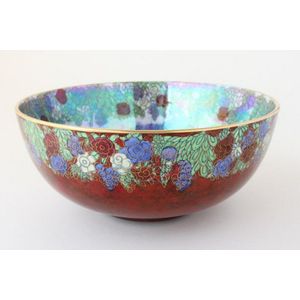French Automaton Clock with Flying Birds and Water Fountain
You must be a subscriber, and be logged in to view price and dealer details.
Subscribe Now to view actual auction price for this item
When you subscribe, you have the option of setting the currency in which to display prices to $Au, $US, $NZ or Stg.
- Gilding - Gilding is a method of ornamentation whereby a thin sheet of gold metal is applied to items made of wood, leather, ceramics, glass and silver for decorative purposes.
For furniture including mirrors, the sheet of gold is usually applied over a coating of gesso. Gesso is a mixture of plaster of Paris and gypsum mixed with water and then applied to the carved wooden frames of mirrors and picture frames as a base for applying the gold leaf. After numerous coats of gesso have been applied, allowed to dry and then sanded a coat of "bole", a usually red coloured mixture of clay and glue is brushed on and allowed to dry, after which the gold leaf is applied. Over time parts of the gilding will rub off so the base colour can be seen. In water gilding, this was generally a blue colour, while in oil gilding, the under layer was often yellow. In Victorian times, gilders frequently used red as a pigment beneath the gold leaf.
Metal was often gilded by a process known as fire gilding. Gold mixed with mercury was applied and heated, causing the mercury to evaporate, the long-term effect of which was to kill or disable the craftsman or woman from mercury poisoning. The pursuit of beauty has claimed many victims, not the least of which were the artists who made those pieces so highly sought after today. - Circa - A Latin term meaning 'about', often used in the antique trade to give an approximate date for the piece, usually considered to be five years on either side of the circa year. Thus, circa 1900 means the piece was made about 1900, probably between 1895 and 1905. The expression is sometimes abbreviated to c.1900.
- Timepiece - In today's usage, the word "clock" is the name given to any instrument used for measuring time, but the word clock is derived from the Celtic word meaning "bell", and traditionally a clock without a bell or chime was known as a timepiece.
This item has been included into following indexes:
- clocks, type
- meat covers / food covers / dish covers - pewter 1,629
Visually similar items

Carlton Ware bowl, of circular form, with deep sides, the interior decorated with a scene of bridge and garden in lustre tones of green, purple and red, with a rouge exterior, diameter 21.5 cm

Two Halltonware Sydney Harbour Bridge souvenir handled sweet dishes + a Sydney Harbour Bridge souvenir comport [3]

A Boch Freres Belgian, Keramis, Art Deco vase, c.1930. Decorated earthenware. Printed stamp to base. Height 15.6 cm

Diamond bangle, featuring a diamond plaque comprised of a line of eleven bezel set diamonds surrounded by a cluster of bezel set diamonds, set within a brushed white gold bangle, stamped '14K, 585', approx. Weight 19.8 grams
